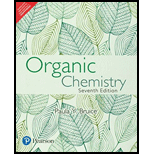
Concept explainers
a)
Interpretation:
The most reactive compound in an electrophilic
Concept Introduction:
Effect of an electron withdrawing or an electron releasing group:
The electron withdrawing or electron releasing groups have significance role in the activation and deactivation of benzene rings during an electrophilic aromatic substitution reaction. An electron withdrawing group deactivates the benzene rings by reducing the electron density on the rings. The electrophilic groups have the tendency to accept or withdraw the electrons from the rest of compound. The deactivating groups are those groups that tend to withdraw the electron density from the benzene ring and decrease the overall
Rule: The rate of reactions in aromatic electrophilic substitution reactions rely upon the presence of an electron releasing or an electron withdrawing group.
b)
Interpretation:
The least reactive compound in an electrophilic aromatic substitution reaction for each row of substituted benzenes has to be predicted.
Concept Introduction:
Effect of an electron withdrawing or an electron releasing group:
The electron withdrawing or electron releasing groups have significance role in the activation and deactivation of benzene rings during an electrophilic aromatic substitution reaction. An electron withdrawing group deactivates the benzene rings by reducing the electron density on the rings. The electrophilic groups have the tendency to accept or withdraw the electrons from the rest of compound. The deactivating groups are those groups that tend to withdraw the electron density from the benzene ring and decrease the overall rate of reactions.
Rule: The rate of reactions in aromatic electrophilic substitution reactions rely upon the presence of an electron releasing or an electron withdrawing group.
c)
Interpretation:
The compound that yields the highest percentage of a meta product in an electrophilic aromatic substitution reaction for each horizontal row of substituted benzenes has to be stated.
Concept Introduction:
Effect of an electron withdrawing or an electron releasing group:
The electron withdrawing or electron releasing groups have significance role in the activation and deactivation of benzene rings during an electrophilic aromatic substitution reaction. An electron withdrawing group deactivates the benzene rings by reducing the electron density on the rings. The electrophilic groups have the tendency to accept or withdraw the electrons from the rest of compound. The deactivating groups are those groups that tend to withdraw the electron density from the benzene ring and decrease the overall rate of reactions.
Rule: The rate of reactions in aromatic electrophilic substitution reactions rely upon the presence of an electron releasing or an electron withdrawing group.
Want to see the full answer?
Check out a sample textbook solution
Chapter 19 Solutions
Organic Chemistry - MasteringChemistry
 Organic Chemistry: A Guided InquiryChemistryISBN:9780618974122Author:Andrei StraumanisPublisher:Cengage Learning
Organic Chemistry: A Guided InquiryChemistryISBN:9780618974122Author:Andrei StraumanisPublisher:Cengage Learning
